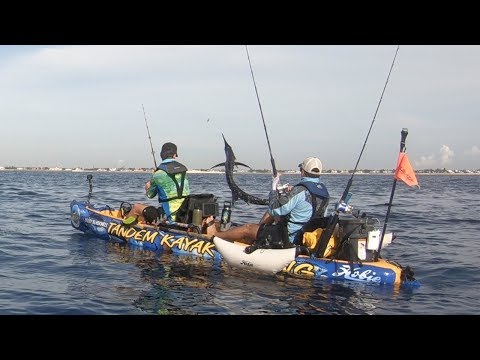Kayaking is a fantastic way to spend the summer with friends and family. Anytime is a good time to be exposed to the tranquility that nature provides. In this guide, we will show you how to get involved in this great hobby. We will also show you what you need to do before getting started on your maiden voyage.
Table of Contents
Should I Buy or Rent?
The first question that needs to be asked. It’s my recommendation that if you are first starting out that you rent a kayak first to see how you like the activity. Rentals usually range anywhere from an hour to a day and start at about $15- 20. A relatively cheap barrier to entry considering. If you find after a few goes that you really like to kayak and can see yourself enjoying this new hobby then that is when you take the plunge to buy. In the long run, it will be cheaper to do this when you own your own kayak.
What you need before you go
If you are renting a kayak, usually they will have most of the equipment you need to get started, minus some snacks and water. If you are in the market to buy a kayak the first things you should get are basic safety equipment. We wrote an in-depth guide about learning how to kayak by takacatamericas.com.
Essential Kayaking Equipment for Recreational Paddling
- PFD’s (Preferably type III)
- A Paddle (One that floats)
- A Spare Paddle
- Whistle
- Shoes
- First Aid Kit
- Anything that your local Government Recommends to bring.
As you get more into kayaking you may upgrade from your recreational setup and start branching out to different kinds of kayaking such as kayak fishing, sea kayaking, or even white water kayaks if you are a bit crazy. Should you go down this route here are some additional safety equipment you will eventually need for a full day or days out on the water.
Other Equipment for more serious types of Kayaking
- Anchor
- Dry pants
- VHF radio
- First Aid Kit
- Compass or Navigational device
- Spray Skirt
- Bilge Pump
- Wetsuit (if paddling on colder waters)
- Helmet
- Wetsuit (if paddling on colder waters)/kayaking drysuit
Where Should you Kayak if you are a Beginner?
If you are a beginner it’s best to stick with calm water environments that have hardly any waves or currents. The ideal bodies of water to learn are small to medium-sized lakes. Once you get the feel of the kayaks on-water behavior you can start exploring different environments such as larger lakes, slow-moving rivers, and even coastal areas.
Who Should I Kayak with?
The best thing about kayaking is the fact that it’s a great activity you can share with your friends and family! When you are paddling with other people the risk of danger reduces drastically because you potentially have someone who can help you out.
Family:
Kayaking is a great family activity that you can all enjoy together in the great outdoors. Learning new skills together can be a fun new endeavor if everyone is game.
Friends:
Sharing a hobby with a friend is great because you both have something in common right from the start! It allows both you to get out distraction-free and ground yourself on the smooth flowing water. Many studies have shown that being next to flowing water is extremely meditative and helps your mental health.
Solo:
If you’ve kayaked a few times and are comfortable in what you are doing then you can solo paddle. Kayaking by yourself can be a great way to reflect with your thoughts while paddling along seeing new sights and sounds. One of my favorite things about solo paddles is that you never know what might come up! Be sure you tell people where you are going so that they know in the off chance that emergency situations come up.
How to Kayak
Getting excited about going out on your first big kayak adventure is one thing but it’s also quite another to actually get started and do it! Here we will teach you some basics to get started in your kayaking journey.
Getting in and Out of the Kayak
One of the first things you should figure out before even setting foot in the water is where to dock. Before you are about to go out take a look at Google maps for good areas to board from. When you are a beginner the best areas are on a soft sandy beach or off of a dock.
From the Dock:
You want to have a low center of gravity when you are boarding a kayak, that is you want your body to be laying on the dock as you get in. First, put your feet in the kayak and lay down onto the dock on your front, start to inch yourself into the kayak while keeping that low center of gravity. Finally when you are in alignment with your kayak, and it feels stable take the final plop!
To get back onto the dock when you are done kayaking simply do what you did but in reverse. Climb up the dock making sure you have a firm grip on something and start to climb out of the kayak. The first few times it is best to have someone assist you in this.
From the Beach:
From the beach you want the cockpit of the kayak to be at the edge of the water. If you have a friend with you, have them hold the kayak steady. You can get in by having each leg on each side of the kayak and doing a squatting motion until you are in the seat of the vessel. As soon as you are balanced push off with your oar into the water. If you are by yourself you do the exact same steps but you hold the paddle behind you and as you are about the get it to hold the kayak steady with the paddle with the other side on the ground. You will use this as leverage where you will be centering your weight onto the paddle and then eventually getting into the kayak.
When getting out of the kayak on the beach simply park it onto the shore (make sure there are no rocks or hard surfaces around) and lift one leg out of the cockpit and the other on either side, then slowly stand up in a squatting motion.
Now What?
So you’ve made it on your first major voyage! Congratulations! Now is the time to reflect on your time on the water and see where you want to go from there. If you thought the experience was meh, then simply rent a kayak when you need to. If you thought it was amazing then most likely you will be getting your own kayak. In this regard, there are many different ways to get started. You can get cheaper hard-bodied recreational kayaks for about $300, or you can get cheaper portable inflatable kayaks that go anywhere from about $80 and up. There are pros and cons to each but ultimately it comes down to on-water performance and space. If you have little space, then an inflatable kayak is most likely for you. If you have space but want some on-water performance get that hard-bodied kayak.



















